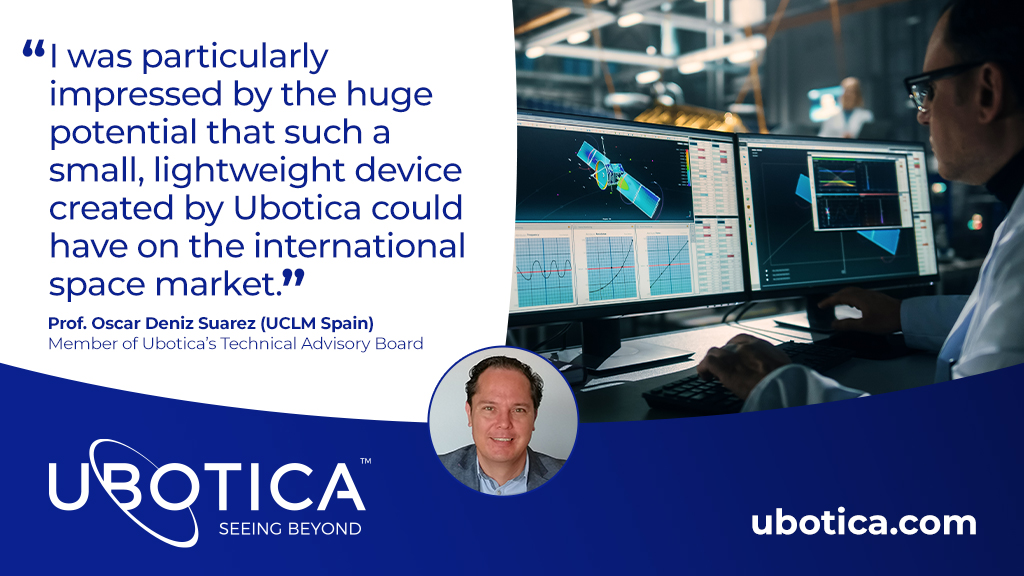Bringing Computer Vision and Pattern Recognition to Space
Bringing Computer Vision and Pattern Recognition to Space
An interview with Prof. Oscar Deniz Suarez (UCLM Spain) Member of Ubotica’s Technical Advisory Board
Tell us a bit about your background in Computer Vision.
I have a degree in computing and an MSc in computer vision. I now work as a professor at the University of Castilla-La Mancha in Spain, which is based near Madrid. I am co-leading a research group and lab around computer vision and its use in multiple applications around automatic surveillance (detecting abandoned luggage, weapons surveillance, …) and medical image analysis.
You are also a member of several international industry associations?
I am a part of the European Laboratory for Learning and Intelligent Systems (ELLIS), as well as a reviewer for R&D projects for several other organisations, both here in Spain and across Europe.
You are also an editor and writer?
I am Editor for a journal called Plos One, as well as other titles, including the Ibero-American Journal of Automatics and Industrial Computer Science and Electronics. I oversee the review process for articles related to computer vision and artificial intelligence in general.
When did you join the Ubotica Technical Advisory Board and how did that come about?
I joined the Ubotica Advisory Board in 2018, although my connection with Ubotica goes back further than that. I was the coordinator of a European project back in 2015 called ‘Eyes of Things’. I was approached by the team who at the time were looking for uses and applications for the Myriad chip. At the time I was, coincidentally, looking for a hardware platform with specific capabilities for embedded mobile computer vision. Back then, we were using smartphones with their inbuilt cameras but obviously smartphones are neither wearable nor open to other uses. We didn’t have anything small or lightweight enough that was also cheap, power efficient and battery operated.
What was your first technology project collaboration with Ubotica?
The first project we collaborated on was an embedded computer vision platform. Essentially, this was a circuit board based around the Myriad chip, with a few other components optimised for power consumption, plus software for computer vision and later for deep learning inference. Together, we were successful in developing a small device, which was battery operated. We carried out several demonstrations around how it could work in various applications, which you can read about on our website. For example, we worked on a museum guide with a headset connected containing the device and a camera that looks at the painting that you are looking at inside the museum. The device automatically recognises the painting and provides more information about it. Another project involved a smart doll. The device is embedded inside the doll and recognises a child’s facial expressions, all from inside the doll without having to send any images to an external Internet server.
How did you make the move into exploring applications for space?
We were very successful as a European project and this was, I believe, the first technology that Ubotica worked on. We have been collaborating on that project ever since, working on increasingly advanced versions of that first circuit board. Eventually, though, we discovered another cool application. We had been focusing on terrestrial applications at first, such as surveillance and mobile robotics, but we hadn’t anticipated that there would be quite so many opportunities in space. At that time, many companies operating within the space sector were using bigger computers because they were proven and reliable. However, they were also bulky, had low power capabilities and did not include any AI functionality at all. We were able to show that there were many advantages to using our device for applications like satellites, which is now proving very successful for all of us.
What’s your specific role on the technical advisory board?
I meet with Ubotica regularly to catch up with the team. I am currently focusing on creating proposals for public funding around space applications and AI in space. I work mainly in Europe as I am based in Spain. I am the main writer for these proposals and a consortium of advisors help me with input and ideas.
Where do you see growth opportunities for Ubotica in the future?
I was particularly impressed by the huge potential that such a small, lightweight device created by Ubotica could have on the international space market. Especially when compared to larger devices that are currently in use. Our deep learning software can also provide the capability to take multiple automatic decisions on board a satellite.
In the long term, I am thinking not just about satellites, but about spacecraft that can venture further away into space exploration. Going to the moon and beyond will require technology like ours due to the long distances involved. You cannot have as many people as you might like inside the spacecrafts in these types of missions. So, more reliance will need to be placed on automatic decisions and the ability to automatically analyse the data gathered by the mission.
How do you help grow the Ubotica team in Europe?
One of the reasons for joining the Ubotica team was that they needed to hire the best people, such as computer science researchers or industrial electronics engineers, when we set up our office in Spain. I helped set up the Spanish branch, negotiated the use of resources with local universities and recruited people to work with us and help us grow. We are always scouting for good people to join us as we expand.
It’s a win-win, as we provide excellent training in computer vision and AI for our people and the company can benefit from their expertise and input to help us grow. We can also provide some excellent opportunities and work contracts for people interested in the sector in which we operate. Many people also work on research projects in the lab at my university as well as working for Ubotica, so it’s a good example of how universities work with start-up companies like ours to help them grow.

